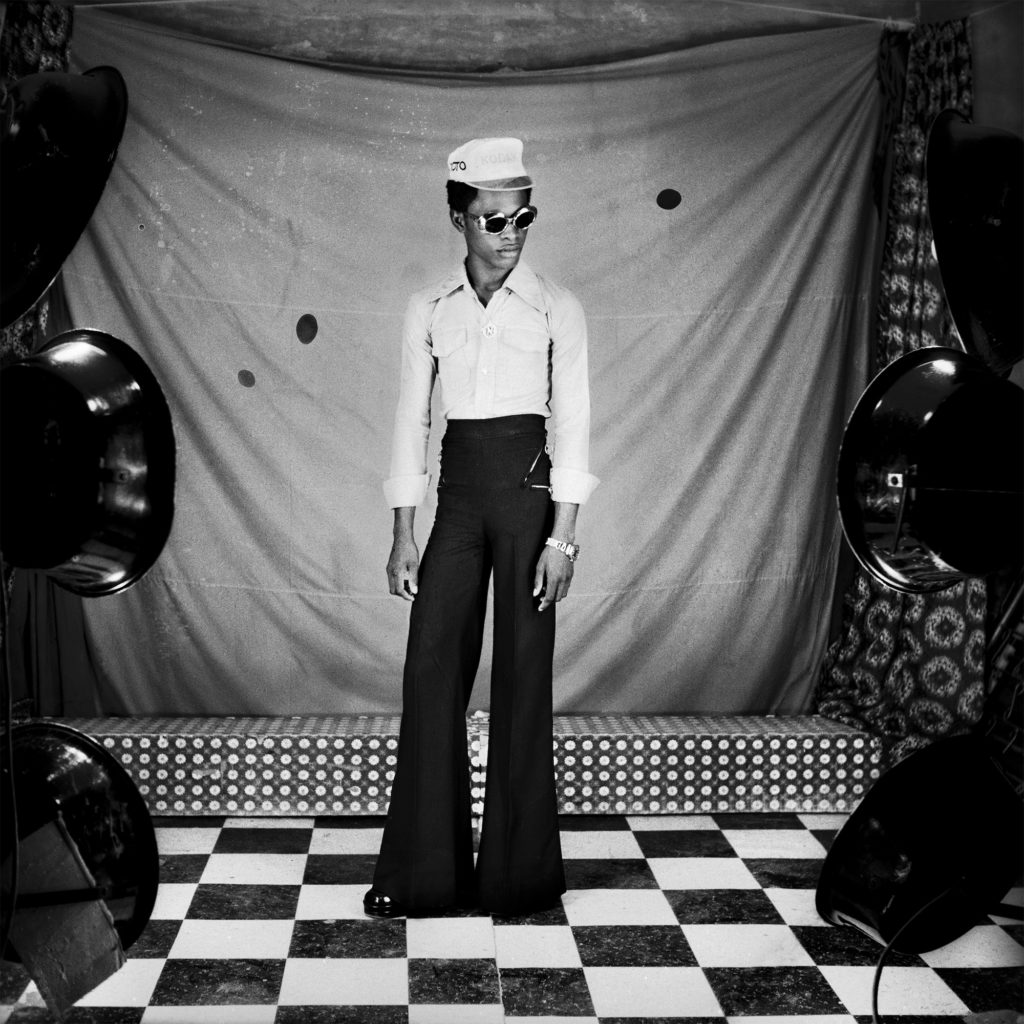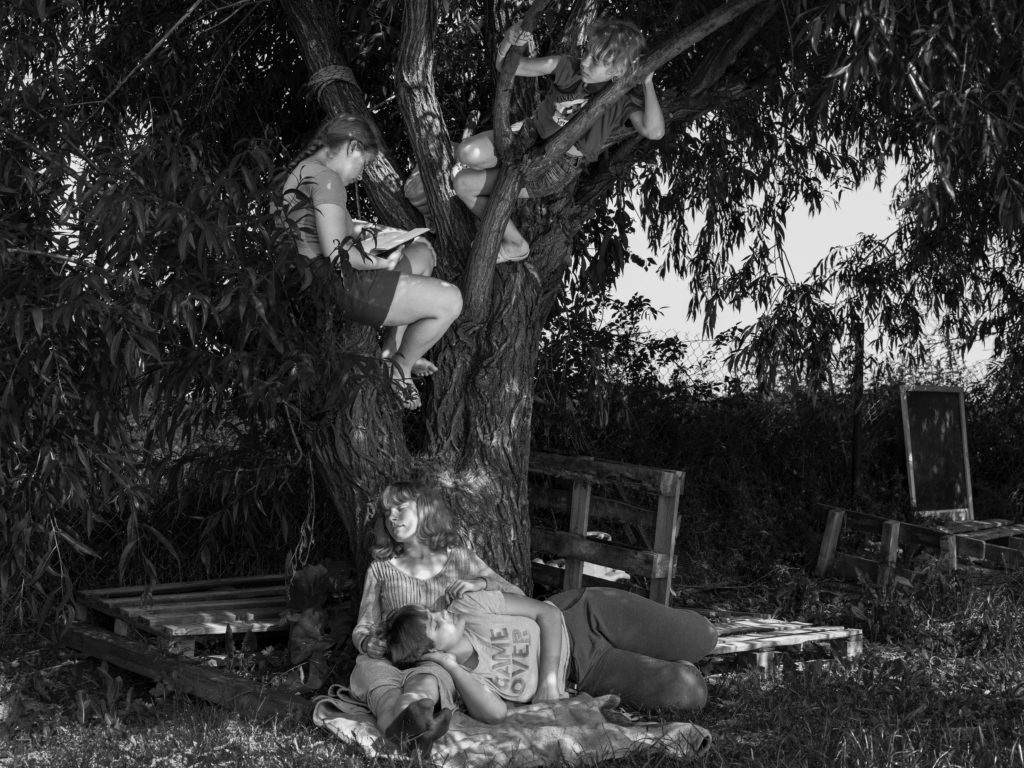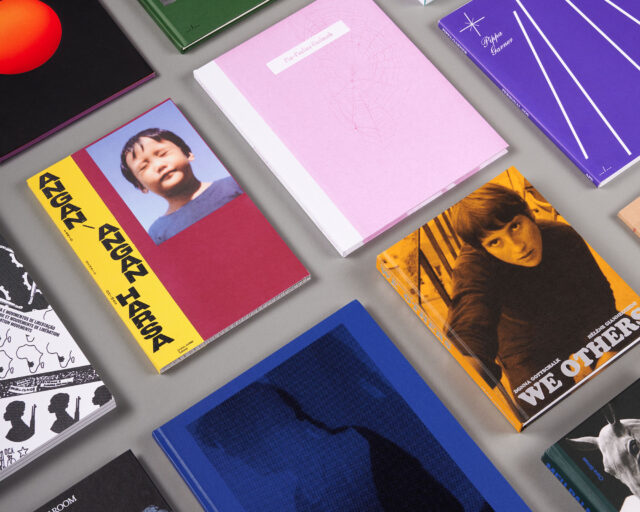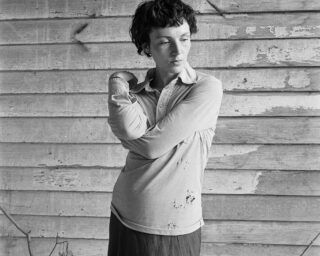2020 PhotoBook Awards Shortlist: PhotoBook of the Year
Paris Photo and Aperture Foundation, in partnership with DELPIRE & CO, are pleased to present the shortlisted books for the 2020 Paris Photo–Aperture Foundation PhotoBook of the Year Award.
The PhotoBook of the Year category highlights excellence in bookmaking, and this year’s shortlist includes a wide range of topics and photographic styles—from Samuel Fosso’s long-awaited monograph of self-portraits, and an arresting collaboration between Dyba and Adam Lach, to this year’s winner, Gloria Oyarzabal’s exploration of colonialism and white feminism in West Africa.
This year’s shortlist was selected by a jury comprised of Joshua Chuang (New York Public Library), Lesley A. Martin (Aperture Foundation), Sarah Hermanson Meister (MoMA), Susan Meiselas (photographer, Magnum Foundation), and Oluremi C. Onabanjo (independent curator and historian).

Courtesy the artist and TBW Books
Knit Club by Carolyn Drake (TBW Books, Oakland, California, 2020)
The mystique that shrouds Magnum photographer Carolyn Drake’s Knit Club is first encountered via its worn-looking cover and musty green-tinted edges; it’s easily mistakable for an old family album. Tucked inside is a series of richly reproduced images that invite you into a community of women with whom Drake embedded herself, developing familial bonds through shared time, wisdom, and secrets. Sarah Meister says, “The seductiveness of the images and the different modes of picture making and subjects makes for a gratifying photobook experience.” Alluding to the Southern Gothic literary form of William Faulkner, Drake weaves together a series of domestic still lifes and portraits into an alluring narrative that both illuminates and obscures. Meister confirms, “The secret parts of being a woman in the world, that men can never understand, are rendered in such a way that only heightens the mystery.”

Courtesy the artist, The Walther Collection, and JM Patras, Paris
Autoportrait by Samuel Fosso (Walther Collection and Steidl, New York, and Göttingen, Germany, 2020)
Samuel Fosso: Autoportrait is the long-awaited and overdue career survey of one of the most unique figures in African photography. Fosso’s conceptual self-portraiture raises themes of sexuality, gender, and self-representation, as the artist inhabits and pays tribute to political icons such as Angela Davis and Martin Luther King Jr., among other Black personas. Autoportrait captures the multitude of his self-expression in what Joshua Chuang describes as a “cohesive, convincing, and definitive volume of Fosso’s most significant work.” Edited by the late Okwui Enwezor—a preeminent curator, critic, and scholar of African photography—this book brims with generously presented images that draw full attention and magnitude to Fosso’s work. Autoportrait “fills a significant gap,” according to Chuang, presenting the artist’s most striking images in a refreshing and comprehensive volume. This landmark monograph exemplifies the full range of the photographic medium in relation to self-presentation, archetypes, and visual culture at large.

Courtesy the artist
Symphony—Mushrooms from the Forest by Takashi Homma (Case Publishing, Tokyo, 2019)
In 2011, just six months after the Fukushima Daiichi nuclear disaster, Japanese photographer Takashi Homma began a series photographing radioactive mushrooms gathered in the forests of Fukushima, before expanding the series to Scandinavia, Chernobyl, and Stony Point, New York. Symphony—Mushrooms from the Forest compiles previously published and new selections from this project. Homma’s primary subjects are photographed against plain white backdrops; interspersed among these are details and landscapes of the various forests in which they were found. “The book is beautifully executed and, for me, revealed something new with each reading,” Chuang says. The work provides “a quiet counterpoint to the sea of visually and emotionally raw imagery that emerged from the tragedy in Fukushima.” Oversized, tactile, and handsomely designed, Symphony—Mushrooms from the Forest is an “oblique and subtle treatment of a freighted subtext through the unexpectedly expressive form of freshly foraged mushrooms,” Chuang praises.

Courtesy the artist
Hoarder Order by Thomas Kuijpers (Fw:Books, Amsterdam, 2020)
In 2014, Thomas Kuijpers purchased a painting depicting the iconic pre-9/11 Twin Towers in New York City, inspiring him to begin collecting images and objects of the towers in an effort to trace the visual representation of politics via this landmark scene. Hoarder Order gathersa range of materials depicting “before” and “after,” now infused with alternate meanings—tourist memorabilia, newspaper clippings, screenshots, movie posters, postcards, and other vernacular material—in a small yet densely elegant 560-page book. Each object is isolated on a page or fills the spread, taking the viewer through a visual timeline of events that resonate outward from the semaphore of these now iconic buildings. The images are printed on Bible-thin paper that allows the viewer to experience a layering of signs, creating a visual metaphor for both what comes next and what has already happened. Susan Meiselas states, “These are the pages of our destiny unfolding, and we can go back and forth—wishing we could return to a different time.”

Courtesy the artist
How to Rejuvenate an Eagle by Adam Lach and Dyba Lach (Self-published, Warsaw, 2020)
A collaborative project between journalist Dyba Lach and photographer Adam Lach, How to Rejuvenate an Eagle examines contemporary Polish history and culture. For three and a half years, the duo traveled extensively throughout the country, conducting over seventy interviews and photographing people and landscapes. Throughout the resulting sequence of black-and-white photographs, excerpts from these interviews are interspersed via quarter-page, red tip-ins. “These textual interventions offer a really elegant interpretation of how one can incorporate multiple voices and perspectives into the making of a contemporary photobook,” Oluremi C. Onabanjo comments. Adam Lach’s arresting photographs are dynamically sequenced and depict a nation deeply conscious of its own historical, geopolitical, and economic transformations—while also struggling with the profound divisions and stereotypes rooted in longstanding cultural schisms.

Courtesy the artist
What Photography & Incarceration Have in Common with an Empty Vase is a two-part photobook by Portuguese photographer Edgar Martins, created in collaboration with inmates at a prison in England’s Midlands region. In this densely packed project, Martins wrestles with crucial questions about the representation of the experience of incarceration. The two volumes are packaged together in a plastic police evidence bag. One is a facsimile of pages from an incarcerated person’s diary; handwritten entries express the frustrations and anxieties of undergoing trial and daily life in prison, occasionally layered with a photograph or drawing by either the author or Martins. “The complementary volume sets up an uneasy juxtaposition,” Meister cautions—opening up questions of truth and fiction, or the equivalencies between shooting a camera and a gun. Martins brings together a heady mix of studio and archival images, documents, and other interventions “to complicate or render impossible any simple read of the subject,” Meister observes.

Courtesy of the Latvian Museum of Photography
Glass Strenči by Orbita (Orbita and the Latvian Museum of Photography, Riga, 2019)
In 1909, Dāvis Spunde began a photography workshop in the Latvian village of Strenči that he and his successors continued through 1950, producing almost 13,000 glass-plate negatives now housed in the Latvian Museum of Photography in Riga. From this archive, editor Anna Volkova and designer Alexey Murashko, members of the creative collective Orbita, selected almost one hundred images, taken between 1930 and 1950. Group portraits of families and laborers, picnics and parades, hospitals, farmlands, and newly installed utility poles, immerse the viewer in the evolving rhythms of life before, during, and after the wars. Each image is presented full-bleed, with an occasional gatefold, luminously printed on a velveteen, uncoated paper. “In the accompanying essay, historian Kirill Kobrin describes the glimpses of life in this village as ‘fragile, strange, attractive, painful, and damned,’” notes Lesley Martin, “which perfectly captures the atmosphere evoked in this mesmerizing selection and presentation of archival images.”

Courtesy Editorial RM
In Woman Go No’Gree, Gloria Oyarzabal asks, “Can we assume social relations in all societies are organized around biological sexual differences?” Oyarzabal tackles this question by exploring colonialism and white feminism in West Africa through the use of found imagery, archives, and her own photography. Inspired by the texts of Oyèrónkẹ́ Oyěwùmí and Ifi Amadiume, Oyarzabal raises questions about the effects of the Western framework of gender and feminism, but not without addressing her own whiteness and privilege—implicating herself in bold green text on the front cover. “What is striking about the declaration on the cover is an acknowledgment of her whiteness, privilege, and mental colonization,” notes Susan Meiselas. “She dares to draw together archival imagery with a contemporary eye, leaving us with layers to unpeel and codes to decipher via extended captions.” In this beautifully and thoughtfully crafted book, Oyarzabal challenges the viewer to engage with their own biases and assumptions.

Courtesy Editorial RM
In 1980, Luis Carlos Tovar’s father, Jaime Tovar, was abducted by FARC (Revolutionary Armed Forces of Colombia). The only evidence that he was still alive was a “proof of life” Polaroid sent by the group to Tovar’s family. That Polaroid acts as a prompt for his book Jardín de mi Padre, which offers a poetic, in-depth reflection on memory and the legacy of the past. Rather than a specific narrative rooted in photographic logic, the book weaves together a mixture of photographs, cyanotypes, and archival ephemera to create a disorienting but riveting visual essay that unfurls the medium in a generative and powerful way. “The journey one takes—whether in regard to memory, family, state violence, or trauma—is one that complicates and collapses our understanding of the past and present,” states Oluremi Onabanjo, “which is important for our understanding of what photobooks can do in 2020.”

Courtesy the artist and Istanbul University Library of Rare Books and Special Collections
Hayal & Hakikat (Dreams & fact) is a reissue of a previously self-published artist book, a compelling intervention into a series of portraits of prisoners found in the archives of the late nineteenth-century Ottoman sultan Abdul Hamid II. The book is uniquely bound via a triple-hinged spine that allows the viewer to unfold and compare the individual sets of images contained within. Each set of top-bound pages presents a detail of prisoners’ hands—classified according to those that are chained and those that are not. Faces are cropped; the focus remains on the hands, echoing a theory that the sultan commissioned these photographs to establish a prisoner’s guilt, believing this could be determined by the length of their thumb joints. “Centering the work on this arbitrary and idiosyncratic means of determining an inmate’s fate speaks obliquely to the current uncertain state of the individual in Turkish politics,” Martin proposes. “It’s also a poetic example of how archives can be reinterpreted and reinfused with both fact and fiction.”
These text were originally published in Issue #18 of The PhotoBook Review.
The 2020 Paris Photo—Aperture Foundation PhotoBook Awards Shortlist Exhibition will be on view at DELPIRE & CO through December 24, 2020. Read more about the 2020 PhotoBook Award Winners here.



























